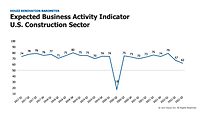Houzz: Architects, Interior Designers Temper Expectations for Q3

Interior designers have a more optimistic view compared to architects of where business is headed in 2022, according to the Q3 2022 Houzz Renovation Barometer released by remodeling an design platform Houzz Inc.
Both groups report slower business activity in Q2 2022 compared to the previous quarter. Regionally, expectations for business activity are the highest among the businesses in the East South Central division (61) and the lowest among businesses in the West North Central division (46).
-
The Expected Business Activity Indicator related to project inquiries and new committed projects declined to 52 in Q3, with interior designers at 68 points versus architects at 42 points. This decline in the overall indicator is primarily driven by lowered expectations for new committed projects at 51 in Q3 (down 17 points relative to Q2). Expectations for project inquiries are also down 11 points in Q3 (52 compared to 63 in Q2).
-
The Project Backlog Indicator is 7.5 weeks in the beginning of Q3, slowly returning to wait times experienced one year ago (7.2 weeks in Q3 2021) after reaching the highest levels since 2017 in Q4 2021 (9.3 weeks) and down slightly from Q1 and Q2 2022 (7.9 weeks).
-
The Recent Business Activity Indicator related to project inquiries and new committed projects declined to 56 in Q2 (compared to 63 in Q1 2022), with interior designers at 62 versus architects at 53. This decline is the result of a drop in project inquiries to 55 (compared to 62 in Q1 2022) and a decrease in new committed projects to 57 (down six points from Q1 2022).
Backlogs also vary across all regional divisions among businesses in the architecture and design services sector, Houzz said. Businesses in the East North Central division (including Illinois, Indiana, Michigan, Ohio and Wisconsin) reported 10.4 week backlogs, while the East South Central division (including Alabama, Kentucky, Mississippi and Tennessee) showed much shorter backlogs at 6.3 weeks. Backlogs reported by architects (13.7 weeks) in the East North Central division are the driving force for long wait times, whereas wait times to begin a new project with an interior designer in that area is only 4.9 weeks. Compared to the same quarter one year ago, backlogs for the architectural and design services sector are longer across five of the nine Census divisions (East North Central, East South Central, Mountain, New England and West North Central divisions).
Looking for a reprint of this article?
From high-res PDFs to custom plaques, order your copy today!






